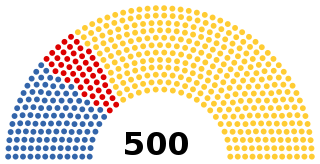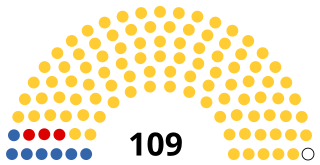 W
WThe Government of the Democratic Republic of the Congo is the second institution in the central executive branch of the Democratic Republic of the Congo, the first institution being the President, who has the title of head of state.
 W
WThe College of Commissioners-General was a body of university graduates that acted as the third government of the Democratic Republic of the Congo under the leadership of Albert Ndele from 20 September 1960 to 3 October 1960 and Justin Marie Bomboko from 3 October 1960 until 9 February 1961.
 W
WThe Constitution of the Democratic Republic of the Congo is the basic law governing the Democratic Republic of the Congo. The Constitution has been changed and/or replaced several times since its independence in 1960.
 W
WThe Lumumba Government was the first set of ministers, ministers of state, and secretaries of state that governed the Democratic Republic of the Congo under the leadership of Prime Minister Patrice Lumumba from 24 June until 12 September 1960. It was hastily formed over the period of several weeks in June, and was supported by a slight majority coalition in Parliament. Weak and divided, its tenure was dominated by a widespread mutiny in the army and two secessions.
 W
WThe Institut Congolais pour la Conservation de la Nature is a Congolese governmental partner tasked with the protection and conservation of the Virunga National Park and Kahuzi-Biega National Park, both UNESCO World Heritage Sites in the Democratic Republic of Congo. Members of the ICCN are charged with the overall protection of the parks and the endangered mountain gorilla. The ICCN works with various national and international NGO partners.
 W
WThis article lists the heads of state (presidents) of the Democratic Republic of the Congo since the country's independence in 1960.
 W
WThe Prime Minister of the Democratic Republic of the Congo Jean-Michel Sama Lukonde assumed the office on 15 February 2021. He announced his cabinet on 12 April 2021.
 W
WThe Lumumba Government, also known as the Lumumba Ministry or Lumumba Cabinet, was the first set of ministers, ministers of state, and secretaries of state that governed the Democratic Republic of the Congo under the leadership of Prime Minister Patrice Lumumba from 24 June until 12 September 1960. The government inherited many problems from the era of the Belgian Congo, a tightly administered colony which for most of its existence had few political freedoms. Its members came from different social classes, different tribes, and held varied political beliefs. Weak and divided, its tenure was dominated by a widespread mutiny in the army and two secessions. An exodus of thousands of Belgian functionaries—who had controlled most of the bureaucracy—left the administration in disarray. The United Nations created a large multinational peacekeeping force to assist the government in reestablishing law and order. Western nations were under the impression that Lumumba was a communist, and the United States, Belgium, and France all worked to undermine and divide his government. Domestic opposition to the government cemented by late July, and Lumumba increasingly relied on only a few advisers, and rarely consulted the full Council of Ministers; several members of the government began acting without his direction. He resorted to increasingly authoritarian measures to maintain control over the country.
 W
WThe Ministry of Hydrocarbons (MoH) is a ministry of the Government of the Democratic Republic of the Congo. It is responsible for the exploration, production, refining, distribution, marketing, import, export, and conservation of petroleum, natural gas, petroleum products, and liquefied natural gas in the Democratic Republic of Congo. It also oversees the safety and other regulations that relate to the exportation and importation of the products into the country. As part of its activities, the department manages the upstream, middle stream and downstream in the Congo.
 W
WThe National Assembly is the lower house and main legislative political body of the Parliament of the Democratic Republic of the Congo. It was established by the 2006 constitution.
 W
WThe Parliament of the Democratic Republic of the Congo consists of two chambers:The Senate The National Assembly
 W
WThe prime minister of the Democratic Republic of the Congo is the head of government of the Democratic Republic of the Congo. The Constitution of the Third Republic grants the Prime Minister a significant amount of power.
 W
WThe Senate is the upper house of the Parliament of the Democratic Republic of the Congo. The senate was established in 1960, abolished in 1967 and re-established in 2003.
 W
WThe Transitional National Assembly of the Democratic Republic of the Congo was an appointed body consisting of representatives of the different parties to the peace agreement that ended the Second Congo War.
 W
WVice-President of the Democratic Republic of Congo is a former political position in Congo, which existed between 2003 and 2006 in the country's interim government after the Second Congo War.